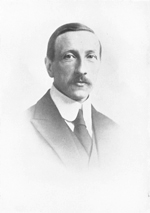Arent Jan Wensinck
Arent Jan Wensinck (born August 7, 1882 in Aarlanderveen , † September 19, 1939 in Leiden ) was a Dutch scholar of Islam , historian of Syrian mystical theology and professor of Semitic languages .
Life
As the son of Johan Herman Wensinck, a Dutch Reformed pastor, and his wife Anna Sara Geertruida Vermeer, Arent Jan Wensinck was initially to follow in his father's footsteps and, after attending grammar schools in Amersfoort and Leiden in 1901, began studying theology at the University of Utrecht . One semester later, however, he decided to study Semitic languages, in which he passed his first exam in 1902 "with praise". He continued these studies from July 1904 at the University of Leiden with the Arabists Michael Jan de Goeje and Christiaan Snouck Hurgronjeand took his doctorate on April 30, 1906. In addition to Hebrew and Aramaic, he also studied Syriac and Arabic, attended lectures in Berlin and Heidelberg and received his doctorate on March 18, 1908 with a dissertation on Mohammed en de Joden te Medina ("Mohammed and the Jews in Medina").
He began his professional career with Hebrew language lessons in secondary schools and as a private lecturer for Syrian and Western Aramaic dialects in Utrecht. At the same time he studied theology in Utrecht and later switched to the Turkologist Martin Houtsma .
In 1912 Wensinck was appointed professor of Hebrew at the University of Leiden , and on October 3 of the same year he married Maria Elisabet Daubanton. The marriage resulted in two sons and two daughters. In 1927/28 he was rector of the University of Leiden .
Wensinck remained connected to the Dutch Reformed Church throughout his life. Shortly before his death in 1939, he wrote the brochure De Nederlandsch-Hervormde Kerk en de Gemeente van Christ , in which he passed on his insights into the liturgy .
As a scholar, Wensinck lived a quiet and reserved life, whose greatest hobby was music, in which he found relaxation. Wensinck enjoyed a high reputation among his colleagues.
plant
Wensinck did not limit himself to his teaching assignment, but also published on the Semitic world in general. In addition to philological studies, these were mainly works on the history of worship that were published by the Royal Netherlands Academy of Sciences , of which he had been a member since 1917. He was particularly fascinated by the studies of mysticism, both in their Christian and Islamic forms. He also made numerous translations from Syriac, such as Kethabha dhe-Jauna in 1919 , the "Book of the Dove" by Bar Hebraeus and in 1923 Mystic treatises , "Mystical Treatises" by Isaac of Nineveh . Later works focused on Ghazali , the greatest Persian mystic of the 11th century; In 1930 Oostersche mystiek appeared: christelijke en mohammedaansche (“Overview of Eastern Mysticism: Christian and Mohammedan”).
In 1927, Wensinck succeeded his mentor Snouck Hurgronje on the chair for Arabic, Syriac and Islamic studies at the University of Leiden.
He was a member of the editorial team of the Encyclopedia of Islam , which, edited by Martinus Theodorus Houtsma , appeared from 1913 to 1938 in five parts and simultaneously in English, French and German. At the same time he published in 1927 A handbook of early Muhammadan tradition ("A handbook of early Muslim traditions") and in 1932 The Muslim creed ("The Muslim creed").
In 1933 the first volume of his Concordance et indices de la Tradition musulmane , a hadith concordance, was published, which was followed by seven more volumes by 1969 and which list all hadiths of the six large collections as well as a few smaller ones with references.
Works
- Arent Jan Wensinck, Johannes H. Kramers (Hrsg.): Concise dictionary of Islam . 2nd Edition. Brill, Leiden 1976, DNB 821257994 .
literature
- Johan Huizinga : Levensbericht van Arent Jan Wensinck . In: Yearbook of the Royal Academy of Sciences 1939-1940 . Amsterdam 1940. Full text
Web links
- Literature by and about Arent Jan Wensinck in the catalog of the German National Library
- StaBiKat proof
- Instituut voor Nederlandse Geschiedenis: Biography AJ Wensinck Dutch
- Works at archive.org
- Wensinck at the DBNL
Individual evidence
- ^ Digitized at archive.org .
| personal data | |
|---|---|
| SURNAME | Wensinck, Arent Jan |
| ALTERNATIVE NAMES | Wensinck, AJ |
| BRIEF DESCRIPTION | Dutch scholar of Islam |
| DATE OF BIRTH | August 7, 1882 |
| PLACE OF BIRTH | Aarlanderveen, Alphen aan den Rijn , Netherlands |
| DATE OF DEATH | September 19, 1939 |
| Place of death | Suffer |
